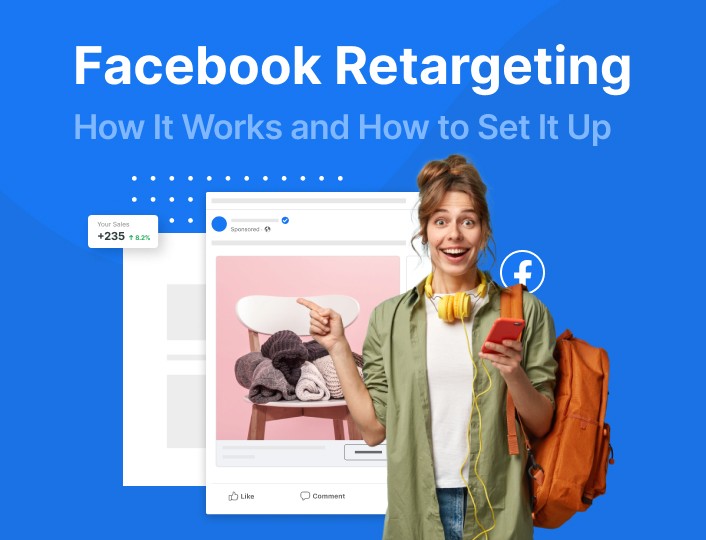Today’s online advertising world is highly competitive. In this scenario, businesses should not let prospective customers slip through the cracks. Facebook Retargeting lets you bring back people who have already shown interest in your product or service but failed to convert into customers earlier. By focusing on these warm leads, you can significantly increase your chances of closing the deal.
In this article, we’ll dive into the power of Facebook retargeting ads, the steps to set them up, and best practices to get the most out of your campaigns.
What Is Facebook Retargeting?
Retargeting, also known as remarketing, is the practice of targeting people who have previously interacted with your website or social media content. These users are more likely to convert since they’ve already shown some level of interest in what you offer.
On Facebook, retargeting is done through custom audiences. You can create an audience of people who visited your site, interacted with your Facebook or Instagram page, or even added items to their cart without completing a purchase. Once you have this audience, you can serve them tailored ads that encourage them to return and finalize their purchase or take another desired action.
Why Is Retargeting Important?
- Increased Conversion Rates
Retargeting ads target users who are already familiar with your brand. Since they have already interacted with your website or content, they’re more likely to convert compared to cold traffic. This results in a higher return on investment (ROI) for your advertising budget. - Cost-Effective Advertising
With retargeting, you can focus your ad spend on users who have shown interest, ensuring your marketing dollars go further. These ads often have a higher click-through rate (CTR), making them more cost-efficient. - Brand Awareness
Even if users don’t convert immediately, seeing your retargeting ads keeps your brand top of mind. Frequent exposure can help nudge them toward a purchase in the future.
How to Set Up Facebook Retargeting Ads?
Setting up retargeting ads on Facebook is simple, especially with Facebook’s Ads Manager. Here’s a step-by-step guide:
- Install the Facebook Pixel
To track user actions on your website, you’ll need to install the Facebook Pixel. This small piece of code allows you to monitor who visits your site, which pages they view, and what actions they take (such as adding items to the cart or completing a purchase). - Create a Custom Audience
Once your pixel is set up, you can create a custom audience. Go to your Facebook Ads Manager, click on “Audiences,” and then click “Create Audience.” You can choose from various options, such as:- Website Traffic: People who have visited your site.
- Engagement: People who have engaged with your Facebook or Instagram page.
- Video Views: Users who have watched your videos on Facebook or Instagram.
- Design Your Retargeting Ad
Now it’s time to create an ad that speaks to your retargeted audience. Here are a few strategies:- Dynamic Ads: These automatically display products that users have viewed or added to their cart but haven’t purchased.
- Carousel Ads: Showcase multiple products or services that the user may be interested in.
- Special Offers: Provide a limited-time discount to entice users to finalize their purchase.
- Content-Based Ads: Offer additional value, such as blog posts or educational content, to nurture the user toward conversion.
- Set Your Budget
Set a daily or lifetime budget for your campaign. Since retargeting focuses on a specific audience, you may not need a huge budget. Start small and scale based on performance. - Track and Optimize
Monitor the performance of your retargeting ads through Facebook Ads Manager. Pay attention to metrics like CTR, conversion rates, and cost per conversion. Use this data to make adjustments, such as testing different ad creatives or adjusting your budget.
Best Practices for Facebook Retargeting Ads
- Segment Your Audience
Not all website visitors are equal. Segment your audience based on their actions. For example, you can create a different ad for users who added a product to their cart versus those who simply visited your site. The more specific your targeting, the more relevant your ads will be. - Time Your Retargeting Ads
Avoid bombarding users with ads immediately after they leave your website. It’s a good idea to give them a few days before showing them a retargeting ad. If they don’t convert within a specific time frame (e.g., 7 days), consider sending them an offer or a reminder. - Use Incentives
Offering a discount or a special promotion can encourage users to return and complete their purchase. For example, a “10% off your next purchase” ad can be effective for bringing back users who are still on the fence. - Test and Experiment
Always A/B test your retargeting ads to see what resonates with your audience. Test different ad formats, headlines, calls to action, and offers. Over time, this will help you refine your strategy for maximum impact. - Use Frequency Capping
Seeing the same ad too often can lead to ad fatigue. Use frequency capping to limit how many times a user sees your retargeting ads. This helps avoid annoyance while ensuring that the ads still remain effective.
Conclusion
Facebook retargeting is a powerful tool for bringing back interested customers and increasing conversions. By targeting users who have already shown interest in your brand, you can remind them of the value you offer and encourage them to take the next step. Follow the steps outlined in this guide, experiment with different strategies, and you’ll be well on your way to boosting your ROI with Facebook retargeting ads.

